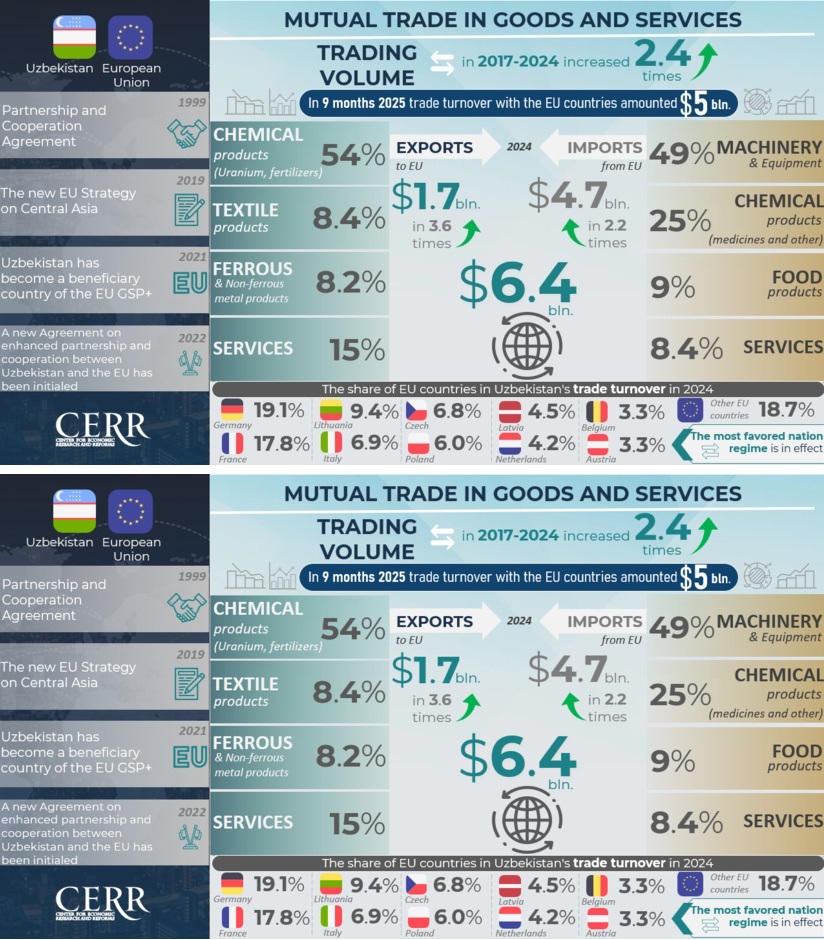Uzbekistan and the European Union: A Step Towards a New Level of Economic Integration

On October 24, in Brussels, the Enhanced Partnership and Cooperation Agreement between Uzbekistan and the European Union will be signed — a document that can rightfully be seen as a turning point in the history of bilateral relations. For Tashkent, this is not merely a diplomatic success but a crucial step towards deepening economic integration, expanding trade and investment ties, and strengthening the country’s position both in Europe and globally.
The signing of the agreement is the logical result of the active dialogue that, in recent years, has taken on a systematic character. Uzbekistan and the European Union have long moved beyond traditional forms of cooperation: they are building a new model of interaction — one that is more flexible, technological, and focused on sustainable development.
Today, the European Union is Uzbekistan’s third-largest trading partner, after China and Russia. In 2024, the share of EU countries in Uzbekistan's foreign trade reached 9.7%, including 6.3% in exports and 12% in imports. According to the Center for Economic Research and Reforms of Uzbekistan, between 2017 and 2024, bilateral trade turnover more than doubled — growing from 2.6 billion USD to 6.4 billion USD. Exports increased 3.6 times, reaching 1.7 billion USD, while imports rose 2.2 times to 4.7 billion USD.
According to the Center for Economic Research and Reforms of Uzbekistan, between 2017 and 2024, the bilateral trade turnover more than doubled — rising from 2.6 billion USD to 6.4 billion USD. Exports grew 3.6 times, reaching 1.7 billion USD, while imports increased 2.2 times, totaling 4.7 billion USD.
Whereas the European Union previously accounted for 3.8% of Uzbekistan's export structure, by 2024, this share had risen to 6.3%. Conversely, the share of imports from the EU decreased from 15.5% to 12%, reflecting the diversification of foreign economic ties, including the expansion of trade flows with Asia. At the same time, in 2024, trade turnover between Uzbekistan and the European Union grew by 5.2%, with exports increasing by 26.9%, while imports remained at the same level as the previous year.
The backbone of Uzbekistan's exports to Europe consists of chemical products, which account for 54% of the total volume — 877.4 million USD. The largest trading partners of Uzbekistan in Europe are Germany (19.1% of trade turnover), France (17.8%), Lithuania (9.4%), Italy (6.9%), the Czech Republic (6.8%), and Poland (6%). By the end of the first nine months of 2025, bilateral trade turnover had already reached 5 billion USD, confirming the steady growth and strategic focus of the partnership.
Equally dynamic is the development of investment cooperation. In 2024, the volume of foreign direct investments and loans from EU countries, including contributions from European financial institutions, increased by 77%, reaching 4.1 billion USD, up from 2.3 billion USD the previous year.
From 2017 to 2024, Uzbekistan attracted 12.4 billion USD in investments and loans from the European Union — 18 times more than in 2017. The largest investors were Germany (1.4 billion USD), the Netherlands (1.1 billion USD), Cyprus (858.9 million USD), the Czech Republic (137.8 million USD), Italy (99.8 million USD), and Sweden (97.5 million USD).
Currently, around 1,000 enterprises with EU capital are operating in Uzbekistan, with over 200 of them having German participation.
The signing of the Agreement on Enhanced Partnership and Cooperation opens up new opportunities for both parties. For Uzbekistan, it is a chance to accelerate industrial modernization, strengthen the position of national businesses in European markets, and attract technologies for the development of priority sectors — renewable energy, chemical and pharmaceutical industries, agriculture, and logistics.
For the European Union, deepening cooperation with Tashkent is an entry into the rapidly developing Central Asian market and access to strategic resources that are becoming increasingly sought after during the transition to a green economy.
This new agreement not only expands the legal framework of interaction but also reflects a new philosophy of partnership — one based on mutual benefit, innovative exchange, and shared responsibility for sustainable development.






